The Role of Cultural Diverse Teams in a Global Virtual Team
VerifiedAdded on 2023/06/08
|18
|4603
|498
AI Summary
This report examines the definition and characteristics of a Global Virtual Team (GVT), the benefits and problems associated with using culturally diverse teams in a GVT, and effective solutions to reduce problems related to culturally diverse teams. The report also discusses communication problems, conflicts, lack of trust among members, problems related to media choice, and difficulty in managing a GVT effectively.
Contribute Materials
Your contribution can guide someone’s learning journey. Share your
documents today.
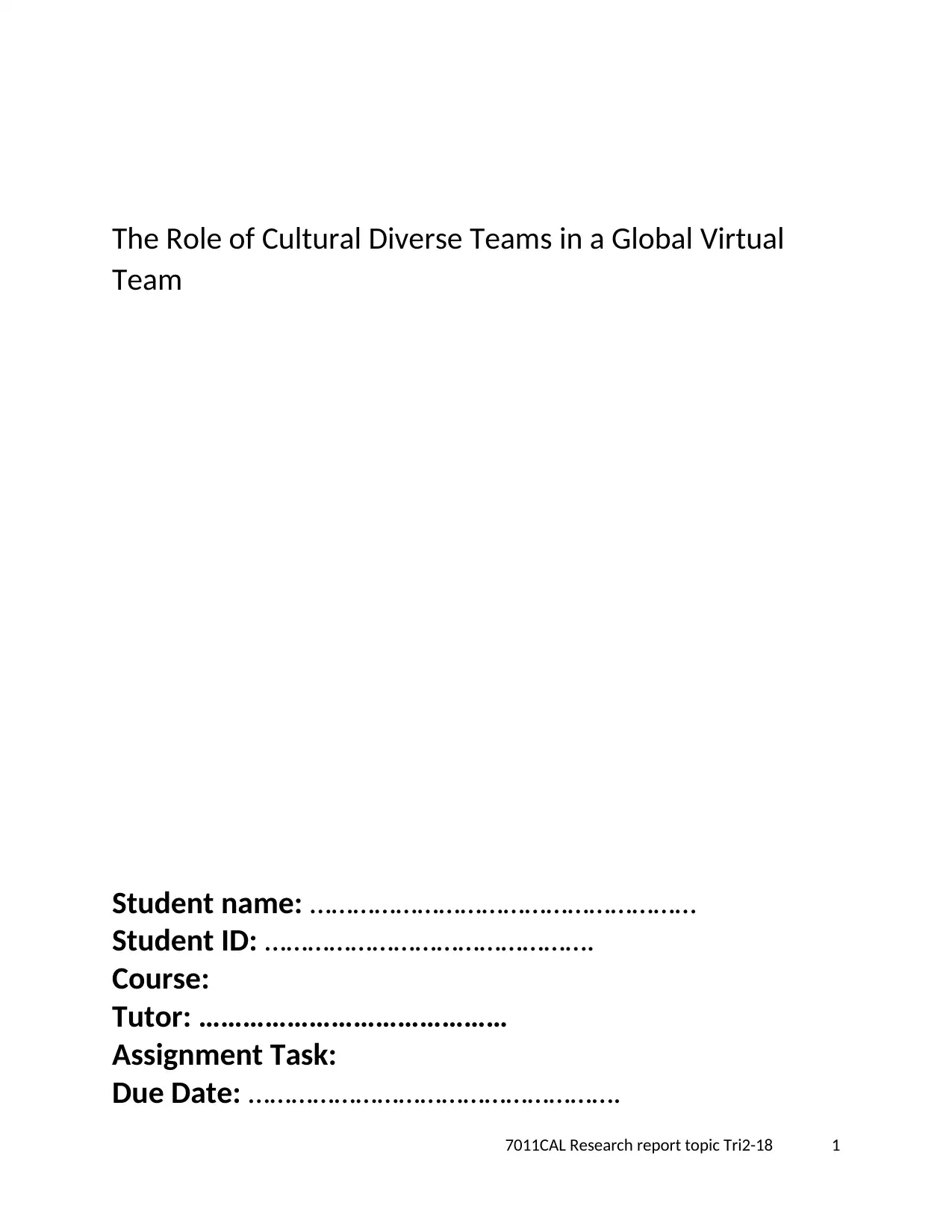
The Role of Cultural Diverse Teams in a Global Virtual
Team
Student name: ………………………………………………
Student ID: ……………………………………….
Course:
Tutor: ……………………………………
Assignment Task:
Due Date: …………………………………………….
7011CAL Research report topic Tri2-18 1
Team
Student name: ………………………………………………
Student ID: ……………………………………….
Course:
Tutor: ……………………………………
Assignment Task:
Due Date: …………………………………………….
7011CAL Research report topic Tri2-18 1
Secure Best Marks with AI Grader
Need help grading? Try our AI Grader for instant feedback on your assignments.
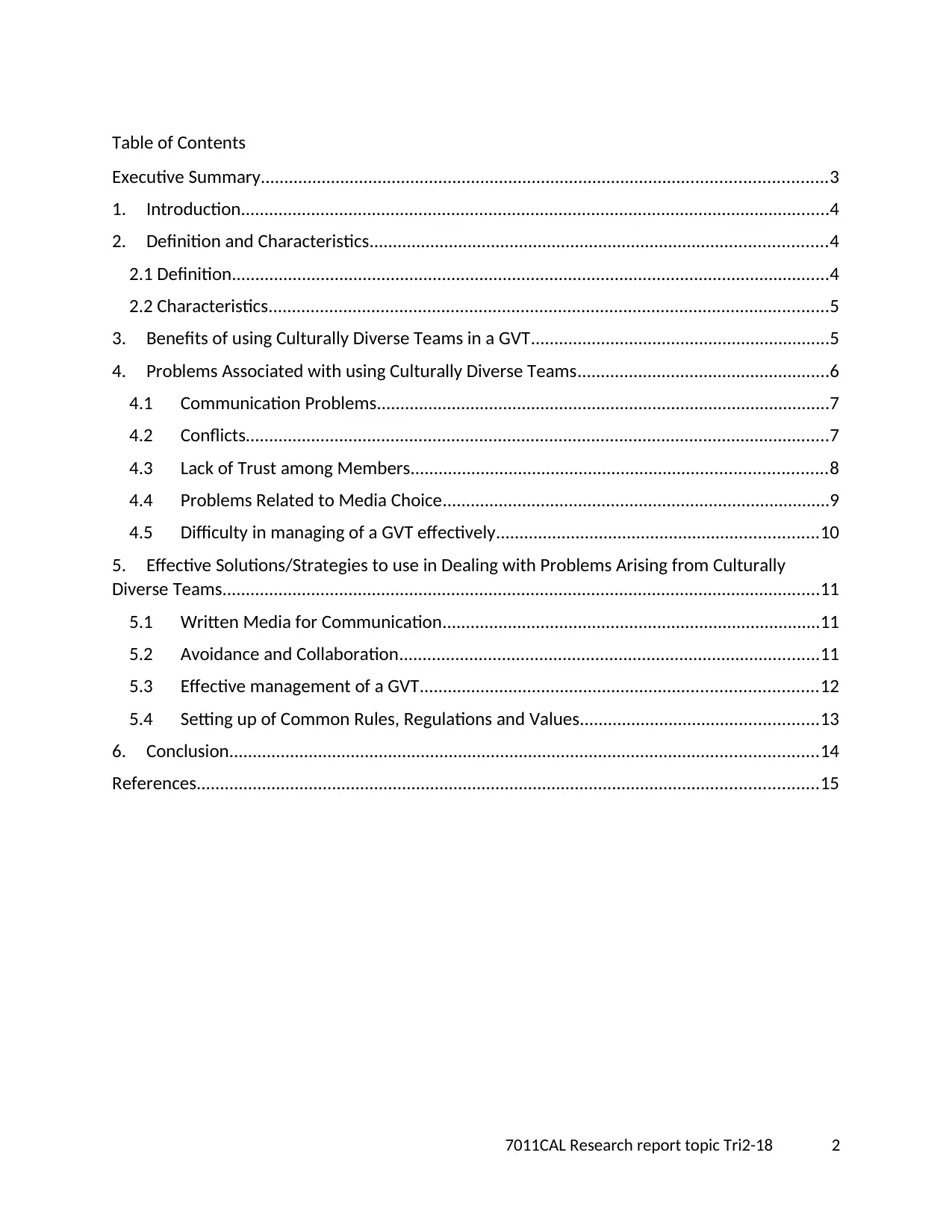
Table of Contents
Executive Summary.........................................................................................................................3
1. Introduction..............................................................................................................................4
2. Definition and Characteristics..................................................................................................4
2.1 Definition................................................................................................................................4
2.2 Characteristics........................................................................................................................5
3. Benefits of using Culturally Diverse Teams in a GVT................................................................5
4. Problems Associated with using Culturally Diverse Teams......................................................6
4.1 Communication Problems.................................................................................................7
4.2 Conflicts.............................................................................................................................7
4.3 Lack of Trust among Members.........................................................................................8
4.4 Problems Related to Media Choice...................................................................................9
4.5 Difficulty in managing of a GVT effectively.....................................................................10
5. Effective Solutions/Strategies to use in Dealing with Problems Arising from Culturally
Diverse Teams................................................................................................................................11
5.1 Written Media for Communication.................................................................................11
5.2 Avoidance and Collaboration..........................................................................................11
5.3 Effective management of a GVT.....................................................................................12
5.4 Setting up of Common Rules, Regulations and Values...................................................13
6. Conclusion..............................................................................................................................14
References.....................................................................................................................................15
7011CAL Research report topic Tri2-18 2
Executive Summary.........................................................................................................................3
1. Introduction..............................................................................................................................4
2. Definition and Characteristics..................................................................................................4
2.1 Definition................................................................................................................................4
2.2 Characteristics........................................................................................................................5
3. Benefits of using Culturally Diverse Teams in a GVT................................................................5
4. Problems Associated with using Culturally Diverse Teams......................................................6
4.1 Communication Problems.................................................................................................7
4.2 Conflicts.............................................................................................................................7
4.3 Lack of Trust among Members.........................................................................................8
4.4 Problems Related to Media Choice...................................................................................9
4.5 Difficulty in managing of a GVT effectively.....................................................................10
5. Effective Solutions/Strategies to use in Dealing with Problems Arising from Culturally
Diverse Teams................................................................................................................................11
5.1 Written Media for Communication.................................................................................11
5.2 Avoidance and Collaboration..........................................................................................11
5.3 Effective management of a GVT.....................................................................................12
5.4 Setting up of Common Rules, Regulations and Values...................................................13
6. Conclusion..............................................................................................................................14
References.....................................................................................................................................15
7011CAL Research report topic Tri2-18 2
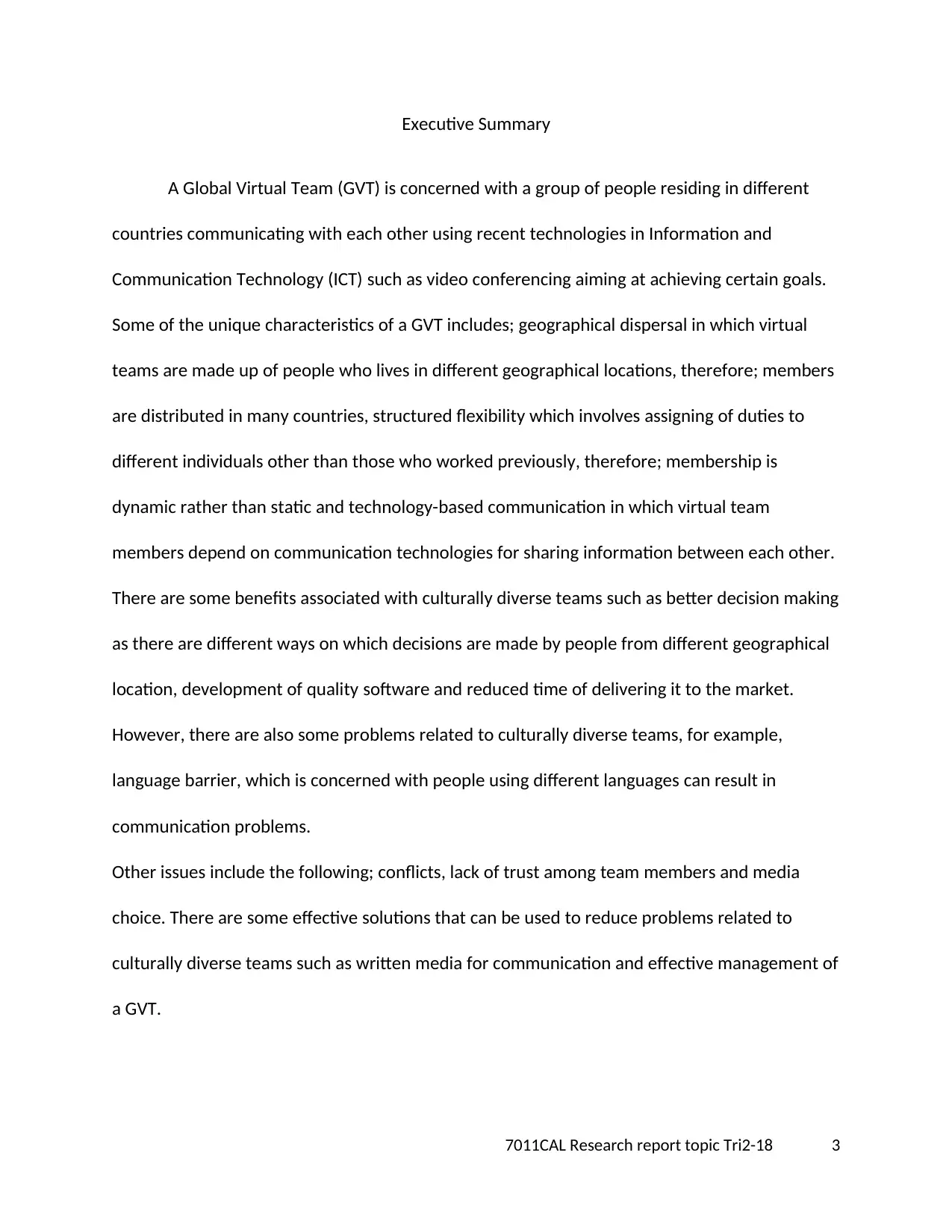
Executive Summary
A Global Virtual Team (GVT) is concerned with a group of people residing in different
countries communicating with each other using recent technologies in Information and
Communication Technology (ICT) such as video conferencing aiming at achieving certain goals.
Some of the unique characteristics of a GVT includes; geographical dispersal in which virtual
teams are made up of people who lives in different geographical locations, therefore; members
are distributed in many countries, structured flexibility which involves assigning of duties to
different individuals other than those who worked previously, therefore; membership is
dynamic rather than static and technology-based communication in which virtual team
members depend on communication technologies for sharing information between each other.
There are some benefits associated with culturally diverse teams such as better decision making
as there are different ways on which decisions are made by people from different geographical
location, development of quality software and reduced time of delivering it to the market.
However, there are also some problems related to culturally diverse teams, for example,
language barrier, which is concerned with people using different languages can result in
communication problems.
Other issues include the following; conflicts, lack of trust among team members and media
choice. There are some effective solutions that can be used to reduce problems related to
culturally diverse teams such as written media for communication and effective management of
a GVT.
7011CAL Research report topic Tri2-18 3
A Global Virtual Team (GVT) is concerned with a group of people residing in different
countries communicating with each other using recent technologies in Information and
Communication Technology (ICT) such as video conferencing aiming at achieving certain goals.
Some of the unique characteristics of a GVT includes; geographical dispersal in which virtual
teams are made up of people who lives in different geographical locations, therefore; members
are distributed in many countries, structured flexibility which involves assigning of duties to
different individuals other than those who worked previously, therefore; membership is
dynamic rather than static and technology-based communication in which virtual team
members depend on communication technologies for sharing information between each other.
There are some benefits associated with culturally diverse teams such as better decision making
as there are different ways on which decisions are made by people from different geographical
location, development of quality software and reduced time of delivering it to the market.
However, there are also some problems related to culturally diverse teams, for example,
language barrier, which is concerned with people using different languages can result in
communication problems.
Other issues include the following; conflicts, lack of trust among team members and media
choice. There are some effective solutions that can be used to reduce problems related to
culturally diverse teams such as written media for communication and effective management of
a GVT.
7011CAL Research report topic Tri2-18 3
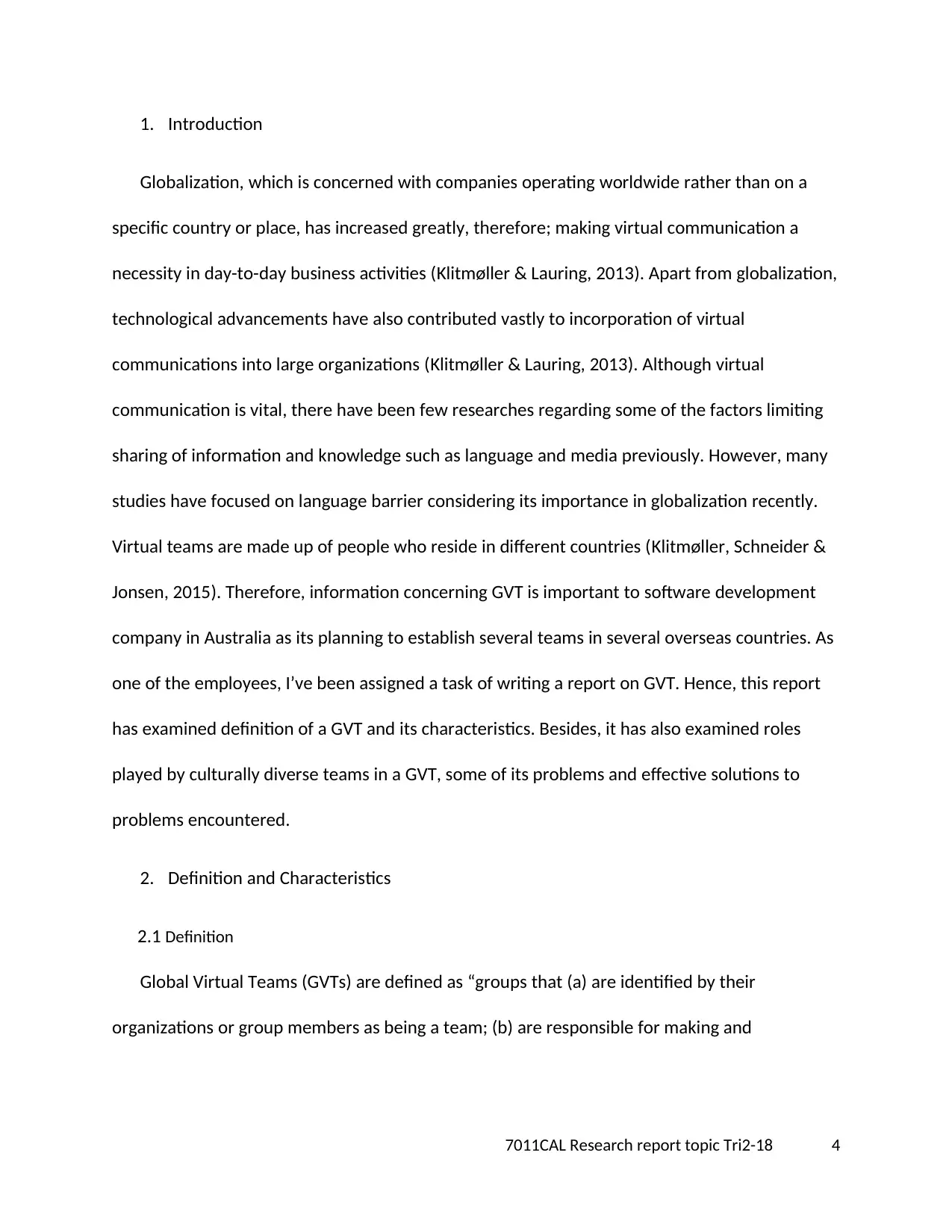
1. Introduction
Globalization, which is concerned with companies operating worldwide rather than on a
specific country or place, has increased greatly, therefore; making virtual communication a
necessity in day-to-day business activities (Klitmøller & Lauring, 2013). Apart from globalization,
technological advancements have also contributed vastly to incorporation of virtual
communications into large organizations (Klitmøller & Lauring, 2013). Although virtual
communication is vital, there have been few researches regarding some of the factors limiting
sharing of information and knowledge such as language and media previously. However, many
studies have focused on language barrier considering its importance in globalization recently.
Virtual teams are made up of people who reside in different countries (Klitmøller, Schneider &
Jonsen, 2015). Therefore, information concerning GVT is important to software development
company in Australia as its planning to establish several teams in several overseas countries. As
one of the employees, I’ve been assigned a task of writing a report on GVT. Hence, this report
has examined definition of a GVT and its characteristics. Besides, it has also examined roles
played by culturally diverse teams in a GVT, some of its problems and effective solutions to
problems encountered.
2. Definition and Characteristics
2.1 Definition
Global Virtual Teams (GVTs) are defined as “groups that (a) are identified by their
organizations or group members as being a team; (b) are responsible for making and
7011CAL Research report topic Tri2-18 4
Globalization, which is concerned with companies operating worldwide rather than on a
specific country or place, has increased greatly, therefore; making virtual communication a
necessity in day-to-day business activities (Klitmøller & Lauring, 2013). Apart from globalization,
technological advancements have also contributed vastly to incorporation of virtual
communications into large organizations (Klitmøller & Lauring, 2013). Although virtual
communication is vital, there have been few researches regarding some of the factors limiting
sharing of information and knowledge such as language and media previously. However, many
studies have focused on language barrier considering its importance in globalization recently.
Virtual teams are made up of people who reside in different countries (Klitmøller, Schneider &
Jonsen, 2015). Therefore, information concerning GVT is important to software development
company in Australia as its planning to establish several teams in several overseas countries. As
one of the employees, I’ve been assigned a task of writing a report on GVT. Hence, this report
has examined definition of a GVT and its characteristics. Besides, it has also examined roles
played by culturally diverse teams in a GVT, some of its problems and effective solutions to
problems encountered.
2. Definition and Characteristics
2.1 Definition
Global Virtual Teams (GVTs) are defined as “groups that (a) are identified by their
organizations or group members as being a team; (b) are responsible for making and
7011CAL Research report topic Tri2-18 4
Secure Best Marks with AI Grader
Need help grading? Try our AI Grader for instant feedback on your assignments.
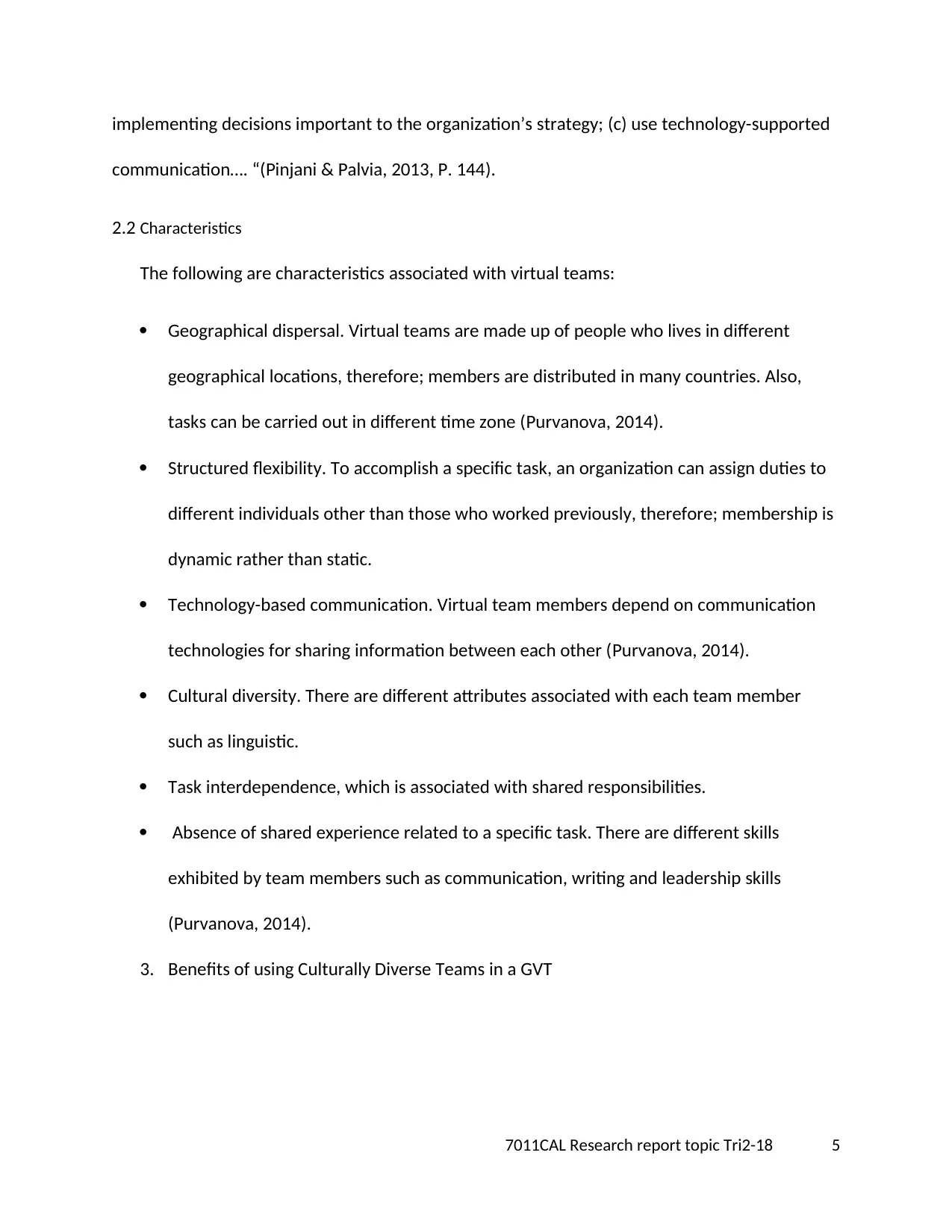
implementing decisions important to the organization’s strategy; (c) use technology-supported
communication…. “(Pinjani & Palvia, 2013, P. 144).
2.2 Characteristics
The following are characteristics associated with virtual teams:
Geographical dispersal. Virtual teams are made up of people who lives in different
geographical locations, therefore; members are distributed in many countries. Also,
tasks can be carried out in different time zone (Purvanova, 2014).
Structured flexibility. To accomplish a specific task, an organization can assign duties to
different individuals other than those who worked previously, therefore; membership is
dynamic rather than static.
Technology-based communication. Virtual team members depend on communication
technologies for sharing information between each other (Purvanova, 2014).
Cultural diversity. There are different attributes associated with each team member
such as linguistic.
Task interdependence, which is associated with shared responsibilities.
Absence of shared experience related to a specific task. There are different skills
exhibited by team members such as communication, writing and leadership skills
(Purvanova, 2014).
3. Benefits of using Culturally Diverse Teams in a GVT
7011CAL Research report topic Tri2-18 5
communication…. “(Pinjani & Palvia, 2013, P. 144).
2.2 Characteristics
The following are characteristics associated with virtual teams:
Geographical dispersal. Virtual teams are made up of people who lives in different
geographical locations, therefore; members are distributed in many countries. Also,
tasks can be carried out in different time zone (Purvanova, 2014).
Structured flexibility. To accomplish a specific task, an organization can assign duties to
different individuals other than those who worked previously, therefore; membership is
dynamic rather than static.
Technology-based communication. Virtual team members depend on communication
technologies for sharing information between each other (Purvanova, 2014).
Cultural diversity. There are different attributes associated with each team member
such as linguistic.
Task interdependence, which is associated with shared responsibilities.
Absence of shared experience related to a specific task. There are different skills
exhibited by team members such as communication, writing and leadership skills
(Purvanova, 2014).
3. Benefits of using Culturally Diverse Teams in a GVT
7011CAL Research report topic Tri2-18 5
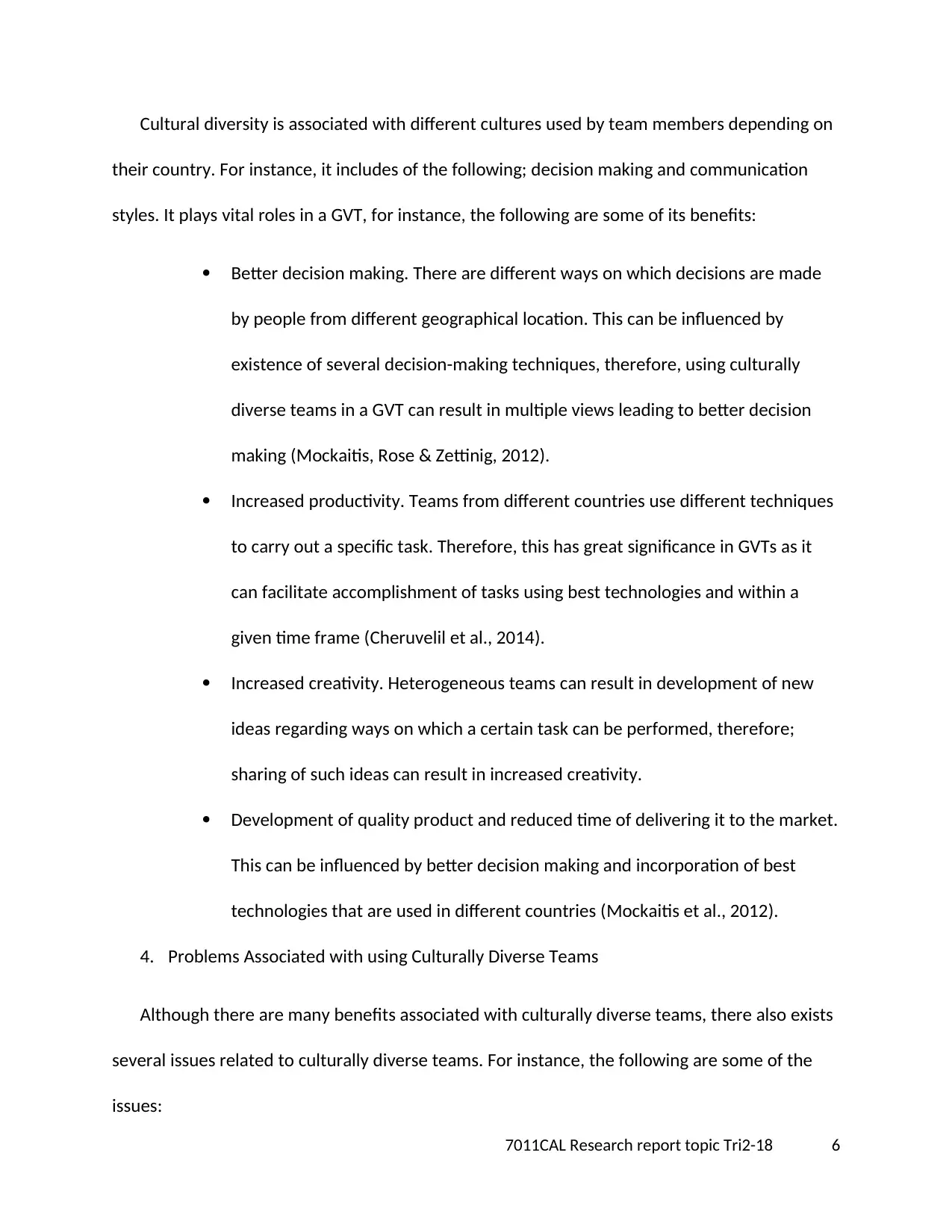
Cultural diversity is associated with different cultures used by team members depending on
their country. For instance, it includes of the following; decision making and communication
styles. It plays vital roles in a GVT, for instance, the following are some of its benefits:
Better decision making. There are different ways on which decisions are made
by people from different geographical location. This can be influenced by
existence of several decision-making techniques, therefore, using culturally
diverse teams in a GVT can result in multiple views leading to better decision
making (Mockaitis, Rose & Zettinig, 2012).
Increased productivity. Teams from different countries use different techniques
to carry out a specific task. Therefore, this has great significance in GVTs as it
can facilitate accomplishment of tasks using best technologies and within a
given time frame (Cheruvelil et al., 2014).
Increased creativity. Heterogeneous teams can result in development of new
ideas regarding ways on which a certain task can be performed, therefore;
sharing of such ideas can result in increased creativity.
Development of quality product and reduced time of delivering it to the market.
This can be influenced by better decision making and incorporation of best
technologies that are used in different countries (Mockaitis et al., 2012).
4. Problems Associated with using Culturally Diverse Teams
Although there are many benefits associated with culturally diverse teams, there also exists
several issues related to culturally diverse teams. For instance, the following are some of the
issues:
7011CAL Research report topic Tri2-18 6
their country. For instance, it includes of the following; decision making and communication
styles. It plays vital roles in a GVT, for instance, the following are some of its benefits:
Better decision making. There are different ways on which decisions are made
by people from different geographical location. This can be influenced by
existence of several decision-making techniques, therefore, using culturally
diverse teams in a GVT can result in multiple views leading to better decision
making (Mockaitis, Rose & Zettinig, 2012).
Increased productivity. Teams from different countries use different techniques
to carry out a specific task. Therefore, this has great significance in GVTs as it
can facilitate accomplishment of tasks using best technologies and within a
given time frame (Cheruvelil et al., 2014).
Increased creativity. Heterogeneous teams can result in development of new
ideas regarding ways on which a certain task can be performed, therefore;
sharing of such ideas can result in increased creativity.
Development of quality product and reduced time of delivering it to the market.
This can be influenced by better decision making and incorporation of best
technologies that are used in different countries (Mockaitis et al., 2012).
4. Problems Associated with using Culturally Diverse Teams
Although there are many benefits associated with culturally diverse teams, there also exists
several issues related to culturally diverse teams. For instance, the following are some of the
issues:
7011CAL Research report topic Tri2-18 6

4.1 Communication Problems
Language barrier, which is concerned with people using different languages, is one of the
main factors resulting in communication problems, therefore; affecting entire process of
sharing information among team members (Tenzer & Pudelko, 2015). For instance, it can result
in miscommunication, thus making it difficult for other members to understand information
clearly. besides, it can also result in time consuming as members spent more time on
translating information that has been shared (Shachaf, 2008). Also, different verbal
communication styles such as direct/indirect and instrumental/affective can also affect
communication process. For instance, direct/indirect styles are concerned with how clear
information is communicated by team members (Shachaf, 2008). Regarding research that was
conducted, Americans stated that other members from countries, for example, China shared
their information using indirect style, therefore; affecting process of communication while
waiting for clarification from Asian global virtual team members. Moreover, personal styles that
are used in communication can also be a problem. For instance, Japanese had some issues of
sharing their information using English language, and consequently, reported that sharing
information in proper social structure was an issue (Shachaf, 2008).
4.2 Conflicts
There are higher chances of conflicts considering different members are used to their
cultures, which is different from that of other members, therefore; agreeing on one culture,
which can include of language or problem-solving technique, may become a source of conflict
(Gibbs, 2009). Emergence of conflicts can affect entire process of communication. For instance,
7011CAL Research report topic Tri2-18 7
Language barrier, which is concerned with people using different languages, is one of the
main factors resulting in communication problems, therefore; affecting entire process of
sharing information among team members (Tenzer & Pudelko, 2015). For instance, it can result
in miscommunication, thus making it difficult for other members to understand information
clearly. besides, it can also result in time consuming as members spent more time on
translating information that has been shared (Shachaf, 2008). Also, different verbal
communication styles such as direct/indirect and instrumental/affective can also affect
communication process. For instance, direct/indirect styles are concerned with how clear
information is communicated by team members (Shachaf, 2008). Regarding research that was
conducted, Americans stated that other members from countries, for example, China shared
their information using indirect style, therefore; affecting process of communication while
waiting for clarification from Asian global virtual team members. Moreover, personal styles that
are used in communication can also be a problem. For instance, Japanese had some issues of
sharing their information using English language, and consequently, reported that sharing
information in proper social structure was an issue (Shachaf, 2008).
4.2 Conflicts
There are higher chances of conflicts considering different members are used to their
cultures, which is different from that of other members, therefore; agreeing on one culture,
which can include of language or problem-solving technique, may become a source of conflict
(Gibbs, 2009). Emergence of conflicts can affect entire process of communication. For instance,
7011CAL Research report topic Tri2-18 7
Paraphrase This Document
Need a fresh take? Get an instant paraphrase of this document with our AI Paraphraser
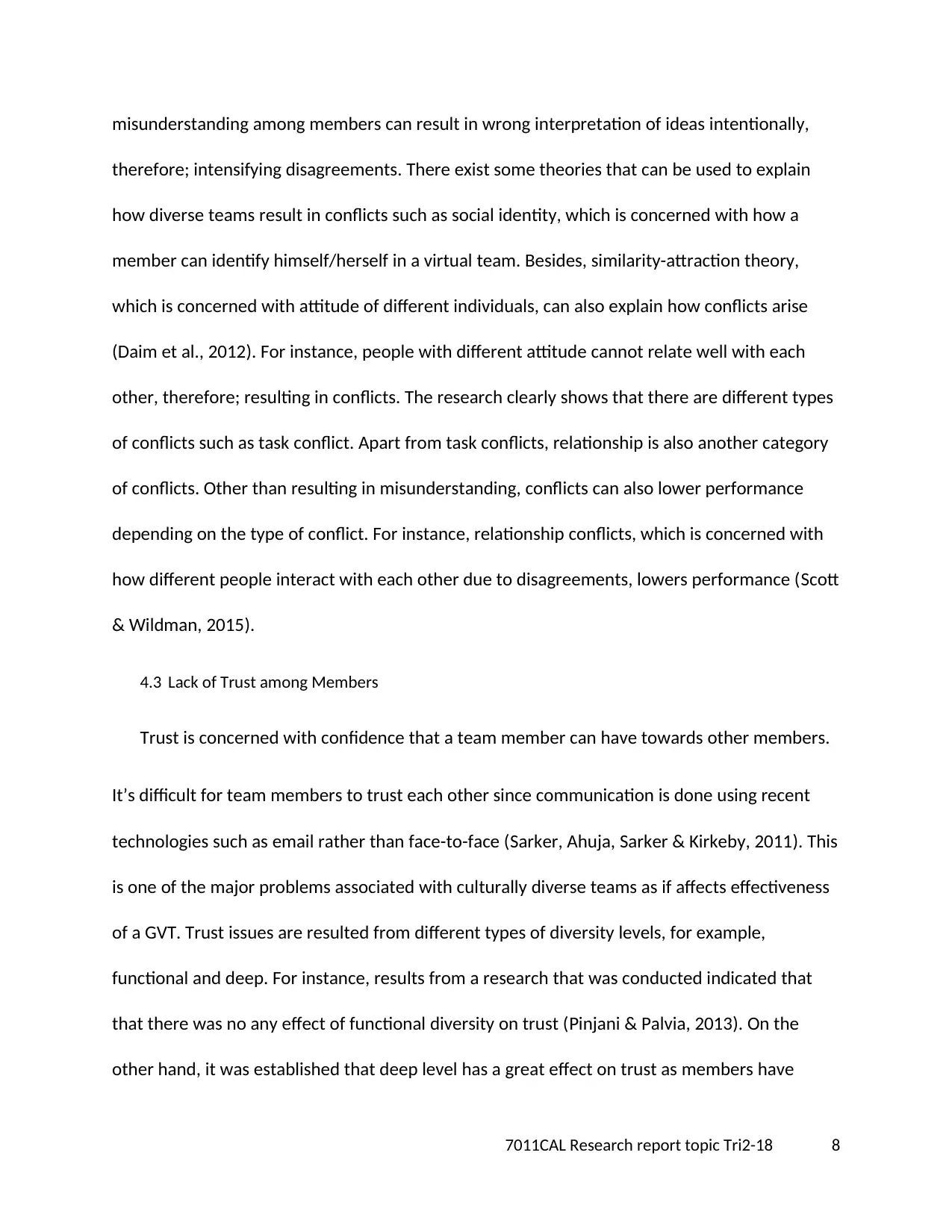
misunderstanding among members can result in wrong interpretation of ideas intentionally,
therefore; intensifying disagreements. There exist some theories that can be used to explain
how diverse teams result in conflicts such as social identity, which is concerned with how a
member can identify himself/herself in a virtual team. Besides, similarity-attraction theory,
which is concerned with attitude of different individuals, can also explain how conflicts arise
(Daim et al., 2012). For instance, people with different attitude cannot relate well with each
other, therefore; resulting in conflicts. The research clearly shows that there are different types
of conflicts such as task conflict. Apart from task conflicts, relationship is also another category
of conflicts. Other than resulting in misunderstanding, conflicts can also lower performance
depending on the type of conflict. For instance, relationship conflicts, which is concerned with
how different people interact with each other due to disagreements, lowers performance (Scott
& Wildman, 2015).
4.3 Lack of Trust among Members
Trust is concerned with confidence that a team member can have towards other members.
It’s difficult for team members to trust each other since communication is done using recent
technologies such as email rather than face-to-face (Sarker, Ahuja, Sarker & Kirkeby, 2011). This
is one of the major problems associated with culturally diverse teams as if affects effectiveness
of a GVT. Trust issues are resulted from different types of diversity levels, for example,
functional and deep. For instance, results from a research that was conducted indicated that
that there was no any effect of functional diversity on trust (Pinjani & Palvia, 2013). On the
other hand, it was established that deep level has a great effect on trust as members have
7011CAL Research report topic Tri2-18 8
therefore; intensifying disagreements. There exist some theories that can be used to explain
how diverse teams result in conflicts such as social identity, which is concerned with how a
member can identify himself/herself in a virtual team. Besides, similarity-attraction theory,
which is concerned with attitude of different individuals, can also explain how conflicts arise
(Daim et al., 2012). For instance, people with different attitude cannot relate well with each
other, therefore; resulting in conflicts. The research clearly shows that there are different types
of conflicts such as task conflict. Apart from task conflicts, relationship is also another category
of conflicts. Other than resulting in misunderstanding, conflicts can also lower performance
depending on the type of conflict. For instance, relationship conflicts, which is concerned with
how different people interact with each other due to disagreements, lowers performance (Scott
& Wildman, 2015).
4.3 Lack of Trust among Members
Trust is concerned with confidence that a team member can have towards other members.
It’s difficult for team members to trust each other since communication is done using recent
technologies such as email rather than face-to-face (Sarker, Ahuja, Sarker & Kirkeby, 2011). This
is one of the major problems associated with culturally diverse teams as if affects effectiveness
of a GVT. Trust issues are resulted from different types of diversity levels, for example,
functional and deep. For instance, results from a research that was conducted indicated that
that there was no any effect of functional diversity on trust (Pinjani & Palvia, 2013). On the
other hand, it was established that deep level has a great effect on trust as members have
7011CAL Research report topic Tri2-18 8
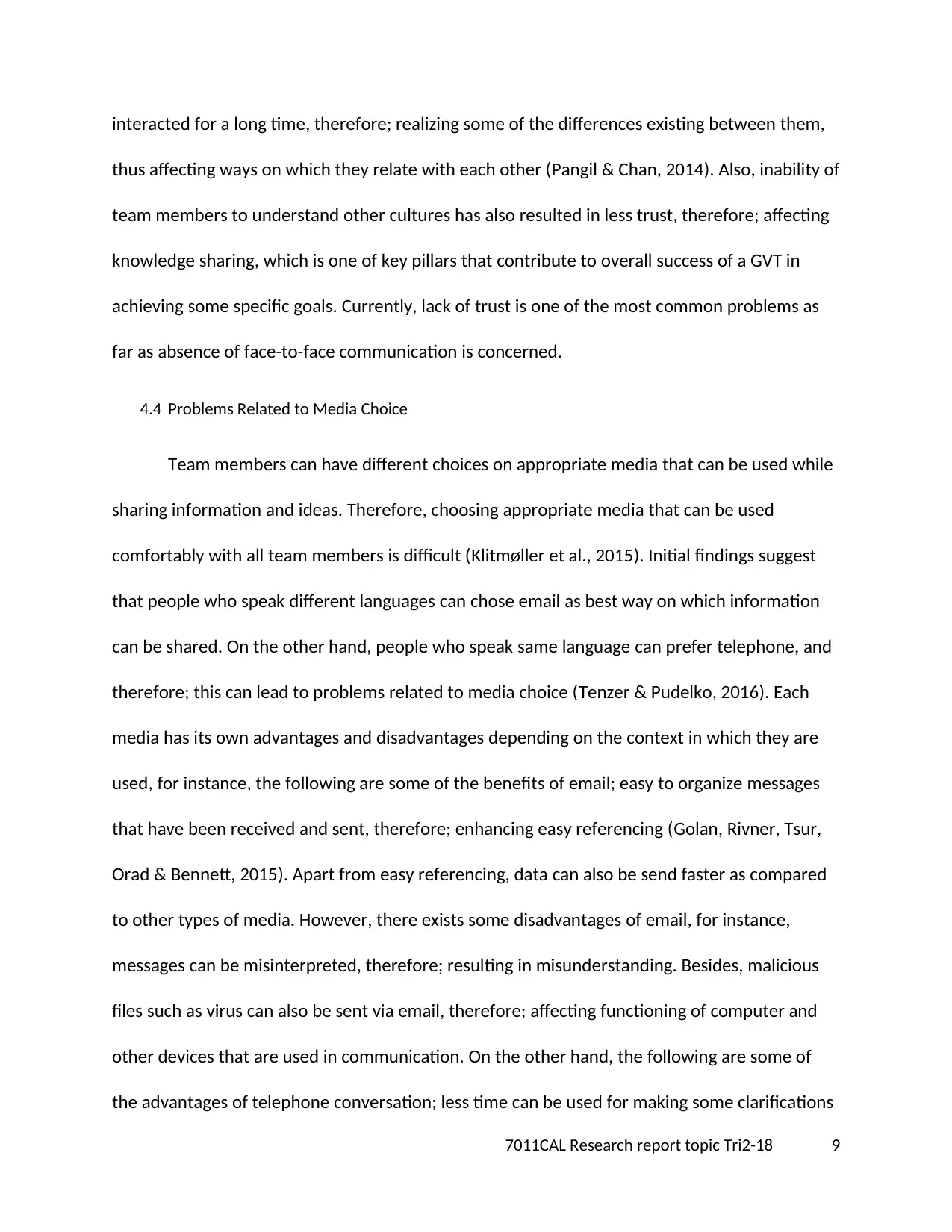
interacted for a long time, therefore; realizing some of the differences existing between them,
thus affecting ways on which they relate with each other (Pangil & Chan, 2014). Also, inability of
team members to understand other cultures has also resulted in less trust, therefore; affecting
knowledge sharing, which is one of key pillars that contribute to overall success of a GVT in
achieving some specific goals. Currently, lack of trust is one of the most common problems as
far as absence of face-to-face communication is concerned.
4.4 Problems Related to Media Choice
Team members can have different choices on appropriate media that can be used while
sharing information and ideas. Therefore, choosing appropriate media that can be used
comfortably with all team members is difficult (Klitmøller et al., 2015). Initial findings suggest
that people who speak different languages can chose email as best way on which information
can be shared. On the other hand, people who speak same language can prefer telephone, and
therefore; this can lead to problems related to media choice (Tenzer & Pudelko, 2016). Each
media has its own advantages and disadvantages depending on the context in which they are
used, for instance, the following are some of the benefits of email; easy to organize messages
that have been received and sent, therefore; enhancing easy referencing (Golan, Rivner, Tsur,
Orad & Bennett, 2015). Apart from easy referencing, data can also be send faster as compared
to other types of media. However, there exists some disadvantages of email, for instance,
messages can be misinterpreted, therefore; resulting in misunderstanding. Besides, malicious
files such as virus can also be sent via email, therefore; affecting functioning of computer and
other devices that are used in communication. On the other hand, the following are some of
the advantages of telephone conversation; less time can be used for making some clarifications
7011CAL Research report topic Tri2-18 9
thus affecting ways on which they relate with each other (Pangil & Chan, 2014). Also, inability of
team members to understand other cultures has also resulted in less trust, therefore; affecting
knowledge sharing, which is one of key pillars that contribute to overall success of a GVT in
achieving some specific goals. Currently, lack of trust is one of the most common problems as
far as absence of face-to-face communication is concerned.
4.4 Problems Related to Media Choice
Team members can have different choices on appropriate media that can be used while
sharing information and ideas. Therefore, choosing appropriate media that can be used
comfortably with all team members is difficult (Klitmøller et al., 2015). Initial findings suggest
that people who speak different languages can chose email as best way on which information
can be shared. On the other hand, people who speak same language can prefer telephone, and
therefore; this can lead to problems related to media choice (Tenzer & Pudelko, 2016). Each
media has its own advantages and disadvantages depending on the context in which they are
used, for instance, the following are some of the benefits of email; easy to organize messages
that have been received and sent, therefore; enhancing easy referencing (Golan, Rivner, Tsur,
Orad & Bennett, 2015). Apart from easy referencing, data can also be send faster as compared
to other types of media. However, there exists some disadvantages of email, for instance,
messages can be misinterpreted, therefore; resulting in misunderstanding. Besides, malicious
files such as virus can also be sent via email, therefore; affecting functioning of computer and
other devices that are used in communication. On the other hand, the following are some of
the advantages of telephone conversation; less time can be used for making some clarifications
7011CAL Research report topic Tri2-18 9
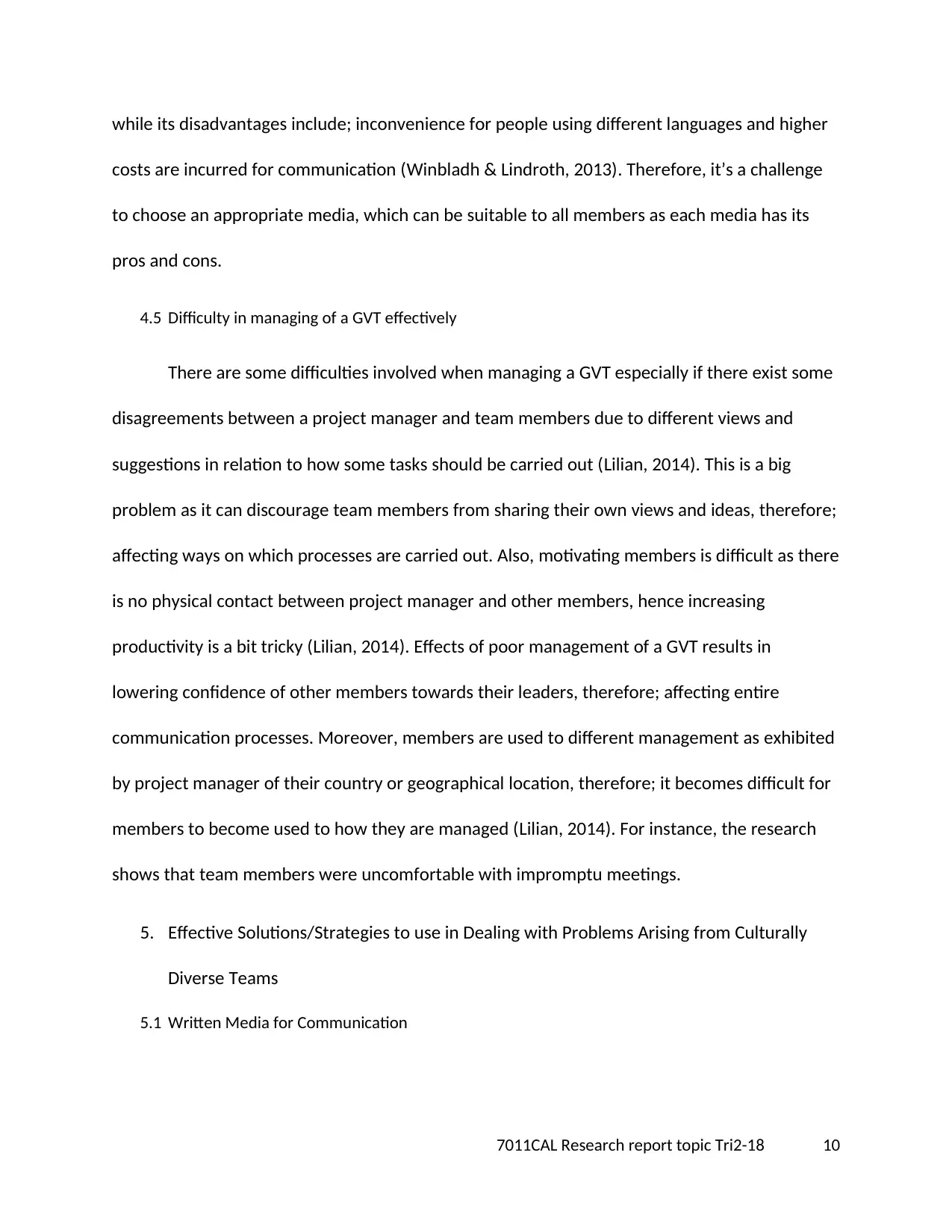
while its disadvantages include; inconvenience for people using different languages and higher
costs are incurred for communication (Winbladh & Lindroth, 2013). Therefore, it’s a challenge
to choose an appropriate media, which can be suitable to all members as each media has its
pros and cons.
4.5 Difficulty in managing of a GVT effectively
There are some difficulties involved when managing a GVT especially if there exist some
disagreements between a project manager and team members due to different views and
suggestions in relation to how some tasks should be carried out (Lilian, 2014). This is a big
problem as it can discourage team members from sharing their own views and ideas, therefore;
affecting ways on which processes are carried out. Also, motivating members is difficult as there
is no physical contact between project manager and other members, hence increasing
productivity is a bit tricky (Lilian, 2014). Effects of poor management of a GVT results in
lowering confidence of other members towards their leaders, therefore; affecting entire
communication processes. Moreover, members are used to different management as exhibited
by project manager of their country or geographical location, therefore; it becomes difficult for
members to become used to how they are managed (Lilian, 2014). For instance, the research
shows that team members were uncomfortable with impromptu meetings.
5. Effective Solutions/Strategies to use in Dealing with Problems Arising from Culturally
Diverse Teams
5.1 Written Media for Communication
7011CAL Research report topic Tri2-18 10
costs are incurred for communication (Winbladh & Lindroth, 2013). Therefore, it’s a challenge
to choose an appropriate media, which can be suitable to all members as each media has its
pros and cons.
4.5 Difficulty in managing of a GVT effectively
There are some difficulties involved when managing a GVT especially if there exist some
disagreements between a project manager and team members due to different views and
suggestions in relation to how some tasks should be carried out (Lilian, 2014). This is a big
problem as it can discourage team members from sharing their own views and ideas, therefore;
affecting ways on which processes are carried out. Also, motivating members is difficult as there
is no physical contact between project manager and other members, hence increasing
productivity is a bit tricky (Lilian, 2014). Effects of poor management of a GVT results in
lowering confidence of other members towards their leaders, therefore; affecting entire
communication processes. Moreover, members are used to different management as exhibited
by project manager of their country or geographical location, therefore; it becomes difficult for
members to become used to how they are managed (Lilian, 2014). For instance, the research
shows that team members were uncomfortable with impromptu meetings.
5. Effective Solutions/Strategies to use in Dealing with Problems Arising from Culturally
Diverse Teams
5.1 Written Media for Communication
7011CAL Research report topic Tri2-18 10
Secure Best Marks with AI Grader
Need help grading? Try our AI Grader for instant feedback on your assignments.
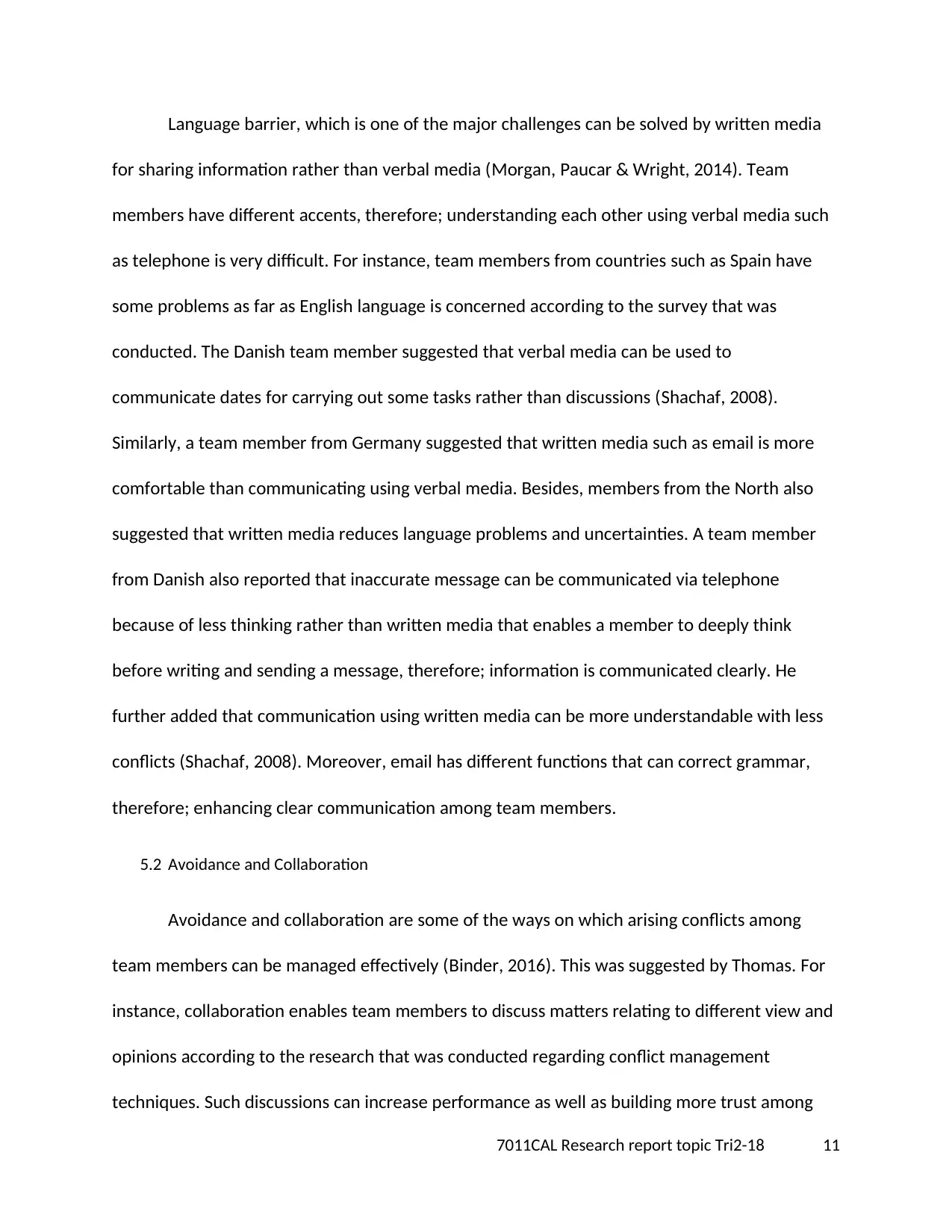
Language barrier, which is one of the major challenges can be solved by written media
for sharing information rather than verbal media (Morgan, Paucar & Wright, 2014). Team
members have different accents, therefore; understanding each other using verbal media such
as telephone is very difficult. For instance, team members from countries such as Spain have
some problems as far as English language is concerned according to the survey that was
conducted. The Danish team member suggested that verbal media can be used to
communicate dates for carrying out some tasks rather than discussions (Shachaf, 2008).
Similarly, a team member from Germany suggested that written media such as email is more
comfortable than communicating using verbal media. Besides, members from the North also
suggested that written media reduces language problems and uncertainties. A team member
from Danish also reported that inaccurate message can be communicated via telephone
because of less thinking rather than written media that enables a member to deeply think
before writing and sending a message, therefore; information is communicated clearly. He
further added that communication using written media can be more understandable with less
conflicts (Shachaf, 2008). Moreover, email has different functions that can correct grammar,
therefore; enhancing clear communication among team members.
5.2 Avoidance and Collaboration
Avoidance and collaboration are some of the ways on which arising conflicts among
team members can be managed effectively (Binder, 2016). This was suggested by Thomas. For
instance, collaboration enables team members to discuss matters relating to different view and
opinions according to the research that was conducted regarding conflict management
techniques. Such discussions can increase performance as well as building more trust among
7011CAL Research report topic Tri2-18 11
for sharing information rather than verbal media (Morgan, Paucar & Wright, 2014). Team
members have different accents, therefore; understanding each other using verbal media such
as telephone is very difficult. For instance, team members from countries such as Spain have
some problems as far as English language is concerned according to the survey that was
conducted. The Danish team member suggested that verbal media can be used to
communicate dates for carrying out some tasks rather than discussions (Shachaf, 2008).
Similarly, a team member from Germany suggested that written media such as email is more
comfortable than communicating using verbal media. Besides, members from the North also
suggested that written media reduces language problems and uncertainties. A team member
from Danish also reported that inaccurate message can be communicated via telephone
because of less thinking rather than written media that enables a member to deeply think
before writing and sending a message, therefore; information is communicated clearly. He
further added that communication using written media can be more understandable with less
conflicts (Shachaf, 2008). Moreover, email has different functions that can correct grammar,
therefore; enhancing clear communication among team members.
5.2 Avoidance and Collaboration
Avoidance and collaboration are some of the ways on which arising conflicts among
team members can be managed effectively (Binder, 2016). This was suggested by Thomas. For
instance, collaboration enables team members to discuss matters relating to different view and
opinions according to the research that was conducted regarding conflict management
techniques. Such discussions can increase performance as well as building more trust among
7011CAL Research report topic Tri2-18 11
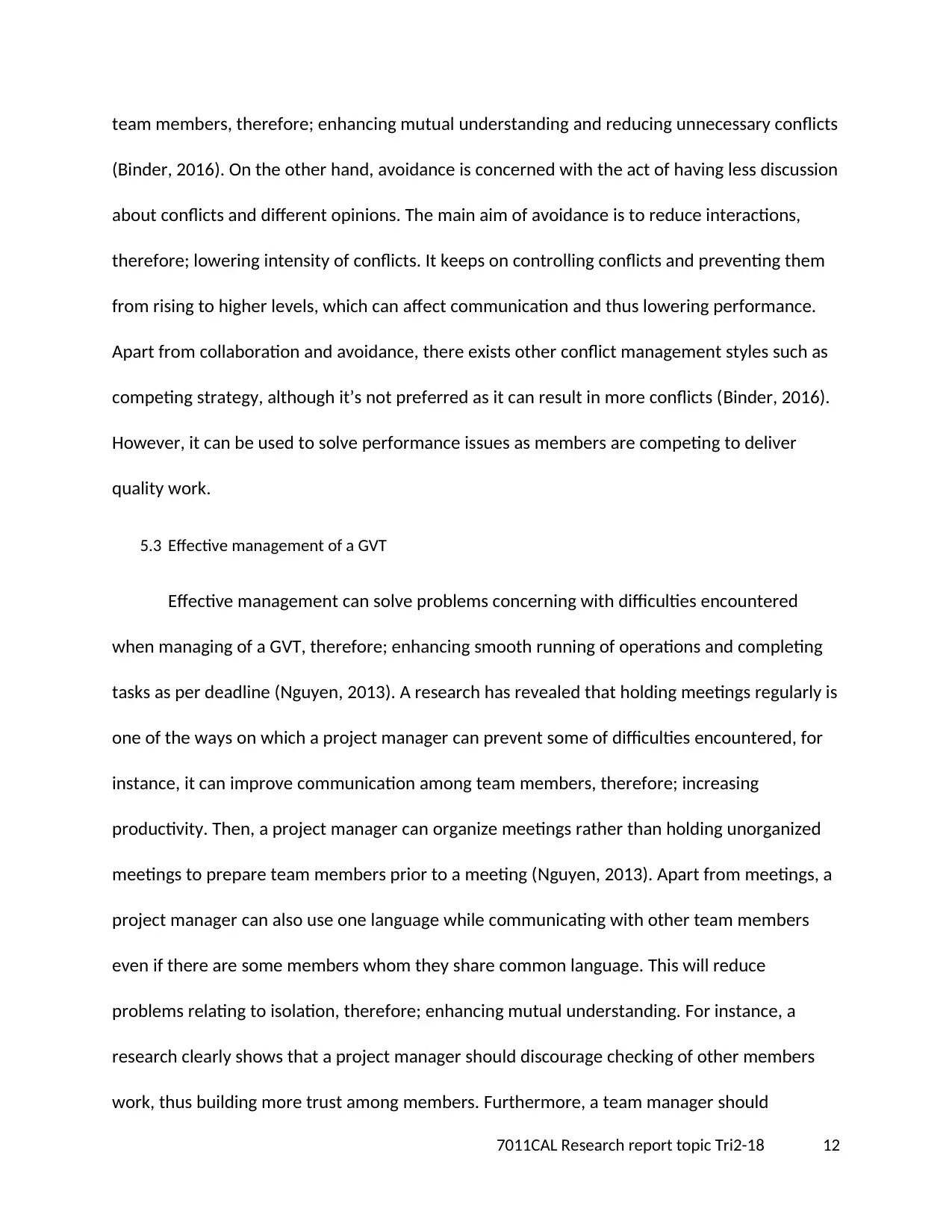
team members, therefore; enhancing mutual understanding and reducing unnecessary conflicts
(Binder, 2016). On the other hand, avoidance is concerned with the act of having less discussion
about conflicts and different opinions. The main aim of avoidance is to reduce interactions,
therefore; lowering intensity of conflicts. It keeps on controlling conflicts and preventing them
from rising to higher levels, which can affect communication and thus lowering performance.
Apart from collaboration and avoidance, there exists other conflict management styles such as
competing strategy, although it’s not preferred as it can result in more conflicts (Binder, 2016).
However, it can be used to solve performance issues as members are competing to deliver
quality work.
5.3 Effective management of a GVT
Effective management can solve problems concerning with difficulties encountered
when managing of a GVT, therefore; enhancing smooth running of operations and completing
tasks as per deadline (Nguyen, 2013). A research has revealed that holding meetings regularly is
one of the ways on which a project manager can prevent some of difficulties encountered, for
instance, it can improve communication among team members, therefore; increasing
productivity. Then, a project manager can organize meetings rather than holding unorganized
meetings to prepare team members prior to a meeting (Nguyen, 2013). Apart from meetings, a
project manager can also use one language while communicating with other team members
even if there are some members whom they share common language. This will reduce
problems relating to isolation, therefore; enhancing mutual understanding. For instance, a
research clearly shows that a project manager should discourage checking of other members
work, thus building more trust among members. Furthermore, a team manager should
7011CAL Research report topic Tri2-18 12
(Binder, 2016). On the other hand, avoidance is concerned with the act of having less discussion
about conflicts and different opinions. The main aim of avoidance is to reduce interactions,
therefore; lowering intensity of conflicts. It keeps on controlling conflicts and preventing them
from rising to higher levels, which can affect communication and thus lowering performance.
Apart from collaboration and avoidance, there exists other conflict management styles such as
competing strategy, although it’s not preferred as it can result in more conflicts (Binder, 2016).
However, it can be used to solve performance issues as members are competing to deliver
quality work.
5.3 Effective management of a GVT
Effective management can solve problems concerning with difficulties encountered
when managing of a GVT, therefore; enhancing smooth running of operations and completing
tasks as per deadline (Nguyen, 2013). A research has revealed that holding meetings regularly is
one of the ways on which a project manager can prevent some of difficulties encountered, for
instance, it can improve communication among team members, therefore; increasing
productivity. Then, a project manager can organize meetings rather than holding unorganized
meetings to prepare team members prior to a meeting (Nguyen, 2013). Apart from meetings, a
project manager can also use one language while communicating with other team members
even if there are some members whom they share common language. This will reduce
problems relating to isolation, therefore; enhancing mutual understanding. For instance, a
research clearly shows that a project manager should discourage checking of other members
work, thus building more trust among members. Furthermore, a team manager should
7011CAL Research report topic Tri2-18 12
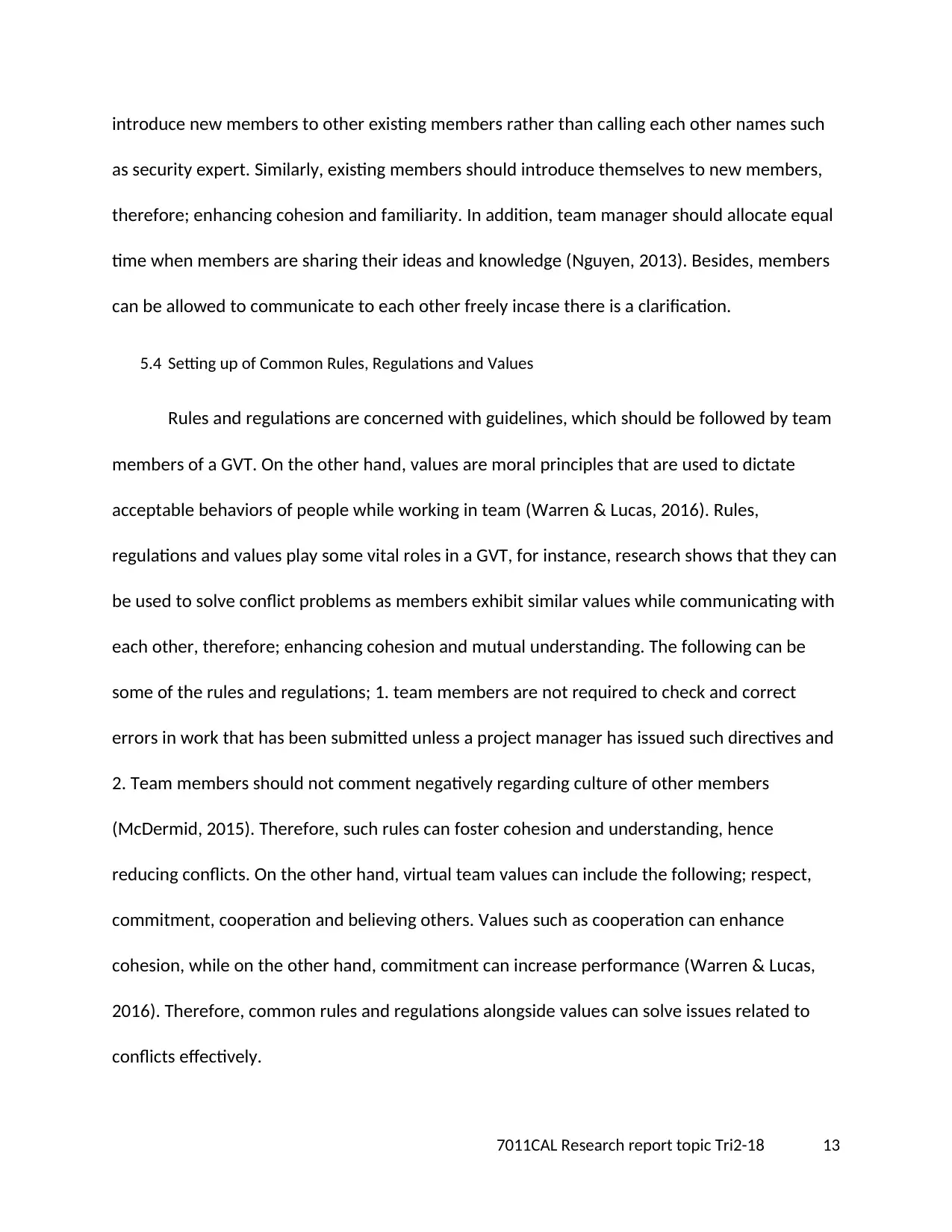
introduce new members to other existing members rather than calling each other names such
as security expert. Similarly, existing members should introduce themselves to new members,
therefore; enhancing cohesion and familiarity. In addition, team manager should allocate equal
time when members are sharing their ideas and knowledge (Nguyen, 2013). Besides, members
can be allowed to communicate to each other freely incase there is a clarification.
5.4 Setting up of Common Rules, Regulations and Values
Rules and regulations are concerned with guidelines, which should be followed by team
members of a GVT. On the other hand, values are moral principles that are used to dictate
acceptable behaviors of people while working in team (Warren & Lucas, 2016). Rules,
regulations and values play some vital roles in a GVT, for instance, research shows that they can
be used to solve conflict problems as members exhibit similar values while communicating with
each other, therefore; enhancing cohesion and mutual understanding. The following can be
some of the rules and regulations; 1. team members are not required to check and correct
errors in work that has been submitted unless a project manager has issued such directives and
2. Team members should not comment negatively regarding culture of other members
(McDermid, 2015). Therefore, such rules can foster cohesion and understanding, hence
reducing conflicts. On the other hand, virtual team values can include the following; respect,
commitment, cooperation and believing others. Values such as cooperation can enhance
cohesion, while on the other hand, commitment can increase performance (Warren & Lucas,
2016). Therefore, common rules and regulations alongside values can solve issues related to
conflicts effectively.
7011CAL Research report topic Tri2-18 13
as security expert. Similarly, existing members should introduce themselves to new members,
therefore; enhancing cohesion and familiarity. In addition, team manager should allocate equal
time when members are sharing their ideas and knowledge (Nguyen, 2013). Besides, members
can be allowed to communicate to each other freely incase there is a clarification.
5.4 Setting up of Common Rules, Regulations and Values
Rules and regulations are concerned with guidelines, which should be followed by team
members of a GVT. On the other hand, values are moral principles that are used to dictate
acceptable behaviors of people while working in team (Warren & Lucas, 2016). Rules,
regulations and values play some vital roles in a GVT, for instance, research shows that they can
be used to solve conflict problems as members exhibit similar values while communicating with
each other, therefore; enhancing cohesion and mutual understanding. The following can be
some of the rules and regulations; 1. team members are not required to check and correct
errors in work that has been submitted unless a project manager has issued such directives and
2. Team members should not comment negatively regarding culture of other members
(McDermid, 2015). Therefore, such rules can foster cohesion and understanding, hence
reducing conflicts. On the other hand, virtual team values can include the following; respect,
commitment, cooperation and believing others. Values such as cooperation can enhance
cohesion, while on the other hand, commitment can increase performance (Warren & Lucas,
2016). Therefore, common rules and regulations alongside values can solve issues related to
conflicts effectively.
7011CAL Research report topic Tri2-18 13
Paraphrase This Document
Need a fresh take? Get an instant paraphrase of this document with our AI Paraphraser

6. Conclusion
The purpose of this report was to define a GVT and stating its characteristics. Also,
examining roles played by culturally diverse teams in a GVT, some of its problems and effective
solutions to problems encountered. GVT is defined as a group of people residing in different
geographical locations and communicating with each other using technologies such as email. Its
characteristics include; geographical dispersal and technology-based communications. Besides,
the following are some benefits of culturally diverse teams in a GVT such as better decision
making, increased productivity and creativity. However, it has some issues such as language
barrier, conflicts, lack of trust and media choice. There are some effective solutions that can be
used to reduce problems related to culturally diverse teams such as written media for
communication and effective management of a GVT. Hence, this report implies that using
culturally diverse teams in a GVT has some pros and cons, therefore; effective solutions should
be applied to minimize issues encountered.
References
Binder, J. (2016). Global project management: communication, collaboration and management
7011CAL Research report topic Tri2-18 14
The purpose of this report was to define a GVT and stating its characteristics. Also,
examining roles played by culturally diverse teams in a GVT, some of its problems and effective
solutions to problems encountered. GVT is defined as a group of people residing in different
geographical locations and communicating with each other using technologies such as email. Its
characteristics include; geographical dispersal and technology-based communications. Besides,
the following are some benefits of culturally diverse teams in a GVT such as better decision
making, increased productivity and creativity. However, it has some issues such as language
barrier, conflicts, lack of trust and media choice. There are some effective solutions that can be
used to reduce problems related to culturally diverse teams such as written media for
communication and effective management of a GVT. Hence, this report implies that using
culturally diverse teams in a GVT has some pros and cons, therefore; effective solutions should
be applied to minimize issues encountered.
References
Binder, J. (2016). Global project management: communication, collaboration and management
7011CAL Research report topic Tri2-18 14
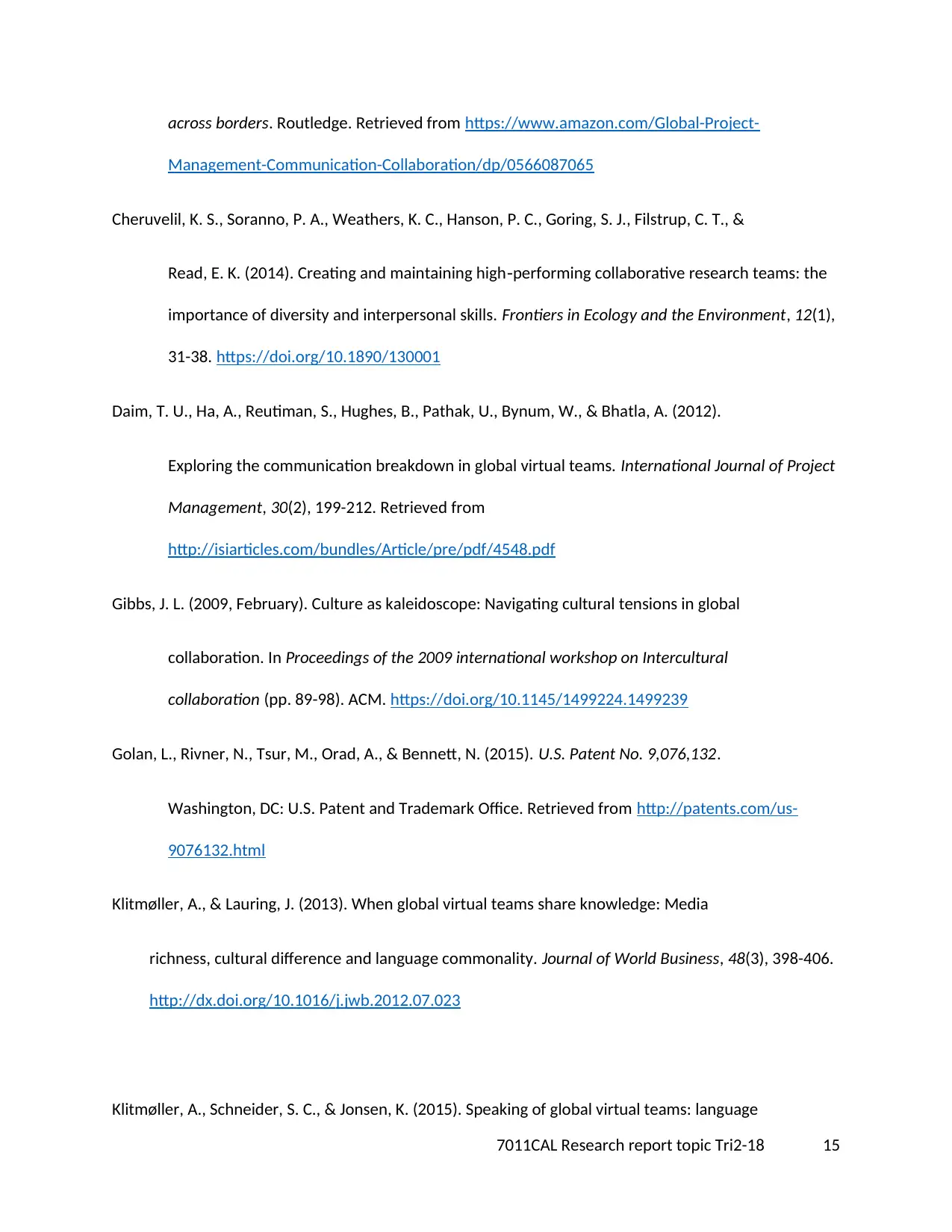
across borders. Routledge. Retrieved from https://www.amazon.com/Global-Project-
Management-Communication-Collaboration/dp/0566087065
Cheruvelil, K. S., Soranno, P. A., Weathers, K. C., Hanson, P. C., Goring, S. J., Filstrup, C. T., &
Read, E. K. (2014). Creating and maintaining high‐performing collaborative research teams: the
importance of diversity and interpersonal skills. Frontiers in Ecology and the Environment, 12(1),
31-38. https://doi.org/10.1890/130001
Daim, T. U., Ha, A., Reutiman, S., Hughes, B., Pathak, U., Bynum, W., & Bhatla, A. (2012).
Exploring the communication breakdown in global virtual teams. International Journal of Project
Management, 30(2), 199-212. Retrieved from
http://isiarticles.com/bundles/Article/pre/pdf/4548.pdf
Gibbs, J. L. (2009, February). Culture as kaleidoscope: Navigating cultural tensions in global
collaboration. In Proceedings of the 2009 international workshop on Intercultural
collaboration (pp. 89-98). ACM. https://doi.org/10.1145/1499224.1499239
Golan, L., Rivner, N., Tsur, M., Orad, A., & Bennett, N. (2015). U.S. Patent No. 9,076,132.
Washington, DC: U.S. Patent and Trademark Office. Retrieved from http://patents.com/us-
9076132.html
Klitmøller, A., & Lauring, J. (2013). When global virtual teams share knowledge: Media
richness, cultural difference and language commonality. Journal of World Business, 48(3), 398-406.
http://dx.doi.org/10.1016/j.jwb.2012.07.023
Klitmøller, A., Schneider, S. C., & Jonsen, K. (2015). Speaking of global virtual teams: language
7011CAL Research report topic Tri2-18 15
Management-Communication-Collaboration/dp/0566087065
Cheruvelil, K. S., Soranno, P. A., Weathers, K. C., Hanson, P. C., Goring, S. J., Filstrup, C. T., &
Read, E. K. (2014). Creating and maintaining high‐performing collaborative research teams: the
importance of diversity and interpersonal skills. Frontiers in Ecology and the Environment, 12(1),
31-38. https://doi.org/10.1890/130001
Daim, T. U., Ha, A., Reutiman, S., Hughes, B., Pathak, U., Bynum, W., & Bhatla, A. (2012).
Exploring the communication breakdown in global virtual teams. International Journal of Project
Management, 30(2), 199-212. Retrieved from
http://isiarticles.com/bundles/Article/pre/pdf/4548.pdf
Gibbs, J. L. (2009, February). Culture as kaleidoscope: Navigating cultural tensions in global
collaboration. In Proceedings of the 2009 international workshop on Intercultural
collaboration (pp. 89-98). ACM. https://doi.org/10.1145/1499224.1499239
Golan, L., Rivner, N., Tsur, M., Orad, A., & Bennett, N. (2015). U.S. Patent No. 9,076,132.
Washington, DC: U.S. Patent and Trademark Office. Retrieved from http://patents.com/us-
9076132.html
Klitmøller, A., & Lauring, J. (2013). When global virtual teams share knowledge: Media
richness, cultural difference and language commonality. Journal of World Business, 48(3), 398-406.
http://dx.doi.org/10.1016/j.jwb.2012.07.023
Klitmøller, A., Schneider, S. C., & Jonsen, K. (2015). Speaking of global virtual teams: language
7011CAL Research report topic Tri2-18 15

differences, social categorization and media choice. Personnel Review, 44(2), 270-285. Retrieved
from https://www.emeraldinsight.com/doi/abs/10.1108/PR-11-2013-0205
Lilian, S. C. (2014). Virtual teams: Opportunities and challenges for e-leaders. Procedia-Social
and Behavioral Sciences, 110, 1251-1261. https://doi.org/10.1016/j.sbspro.2013.12.972
McDermid, D. (2015). Ethics in ICT: an Australian perspective. Pearson Higher Education
AU. Retrieved from http://www.pearson.com.au/products/M-N-McDermid/M-N-McDermid-
Donald/Ethics-In-ICT-An-Australian-perspective/9780733993879?R=9780733993879
Mockaitis, A. I., Rose, E. L., & Zettinig, P. (2012). The power of individual cultural values in
global virtual teams. International Journal of Cross Cultural Management, 12(2), 193-210.
https://doi.org/10.1177/1470595812439868
Morgan, L., Caceres, A. P., & Wright, G. (2014). Leading effective global virtual teams: The
consequences of methods of communication. Systemic Practice and Action Research, 27(6), 607-
624. Retrieved from https://www.deepdyve.com/lp/springer-journals/leading-effective-global-
virtual-teams-the-consequences-of-methods-of-0aKlUD03pr
Nguyen, D. S. (2013). Success factors for building and managing high performance global
virtual teams. International Journal of Sciences: Basic and Applied Research, 9(1), 72-93.
Retrieved from https://www.researchgate.net/profile/Dr_Dan_Nguyen_Phd/publication/
290444883_Success_Factors_for_Building_and_Managing_High_Performance_Global_Virtual_T
eams/links/569f054f08ae4af52544ade7/Success-Factors-for-Building-and-Managing-High-
Performance-Global-Virtual-Teams.pdf
Pangil, F., & Chan, J. M. (2014). The mediating effect of knowledge sharing on the relationship
7011CAL Research report topic Tri2-18 16
from https://www.emeraldinsight.com/doi/abs/10.1108/PR-11-2013-0205
Lilian, S. C. (2014). Virtual teams: Opportunities and challenges for e-leaders. Procedia-Social
and Behavioral Sciences, 110, 1251-1261. https://doi.org/10.1016/j.sbspro.2013.12.972
McDermid, D. (2015). Ethics in ICT: an Australian perspective. Pearson Higher Education
AU. Retrieved from http://www.pearson.com.au/products/M-N-McDermid/M-N-McDermid-
Donald/Ethics-In-ICT-An-Australian-perspective/9780733993879?R=9780733993879
Mockaitis, A. I., Rose, E. L., & Zettinig, P. (2012). The power of individual cultural values in
global virtual teams. International Journal of Cross Cultural Management, 12(2), 193-210.
https://doi.org/10.1177/1470595812439868
Morgan, L., Caceres, A. P., & Wright, G. (2014). Leading effective global virtual teams: The
consequences of methods of communication. Systemic Practice and Action Research, 27(6), 607-
624. Retrieved from https://www.deepdyve.com/lp/springer-journals/leading-effective-global-
virtual-teams-the-consequences-of-methods-of-0aKlUD03pr
Nguyen, D. S. (2013). Success factors for building and managing high performance global
virtual teams. International Journal of Sciences: Basic and Applied Research, 9(1), 72-93.
Retrieved from https://www.researchgate.net/profile/Dr_Dan_Nguyen_Phd/publication/
290444883_Success_Factors_for_Building_and_Managing_High_Performance_Global_Virtual_T
eams/links/569f054f08ae4af52544ade7/Success-Factors-for-Building-and-Managing-High-
Performance-Global-Virtual-Teams.pdf
Pangil, F., & Chan, J. M. (2014). The mediating effect of knowledge sharing on the relationship
7011CAL Research report topic Tri2-18 16
Secure Best Marks with AI Grader
Need help grading? Try our AI Grader for instant feedback on your assignments.
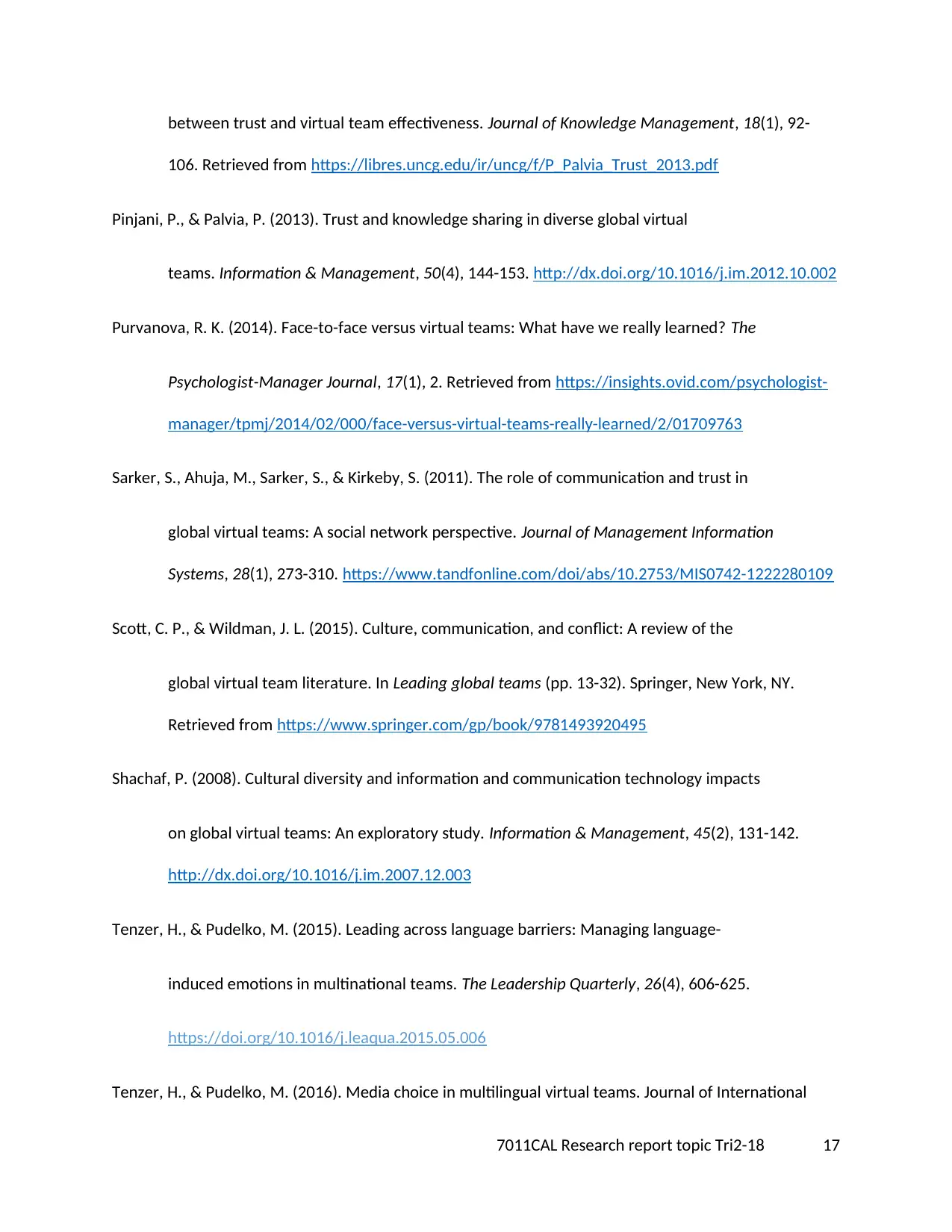
between trust and virtual team effectiveness. Journal of Knowledge Management, 18(1), 92-
106. Retrieved from https://libres.uncg.edu/ir/uncg/f/P_Palvia_Trust_2013.pdf
Pinjani, P., & Palvia, P. (2013). Trust and knowledge sharing in diverse global virtual
teams. Information & Management, 50(4), 144-153. http://dx.doi.org/10.1016/j.im.2012.10.002
Purvanova, R. K. (2014). Face-to-face versus virtual teams: What have we really learned? The
Psychologist-Manager Journal, 17(1), 2. Retrieved from https://insights.ovid.com/psychologist-
manager/tpmj/2014/02/000/face-versus-virtual-teams-really-learned/2/01709763
Sarker, S., Ahuja, M., Sarker, S., & Kirkeby, S. (2011). The role of communication and trust in
global virtual teams: A social network perspective. Journal of Management Information
Systems, 28(1), 273-310. https://www.tandfonline.com/doi/abs/10.2753/MIS0742-1222280109
Scott, C. P., & Wildman, J. L. (2015). Culture, communication, and conflict: A review of the
global virtual team literature. In Leading global teams (pp. 13-32). Springer, New York, NY.
Retrieved from https://www.springer.com/gp/book/9781493920495
Shachaf, P. (2008). Cultural diversity and information and communication technology impacts
on global virtual teams: An exploratory study. Information & Management, 45(2), 131-142.
http://dx.doi.org/10.1016/j.im.2007.12.003
Tenzer, H., & Pudelko, M. (2015). Leading across language barriers: Managing language-
induced emotions in multinational teams. The Leadership Quarterly, 26(4), 606-625.
https://doi.org/10.1016/j.leaqua.2015.05.006
Tenzer, H., & Pudelko, M. (2016). Media choice in multilingual virtual teams. Journal of International
7011CAL Research report topic Tri2-18 17
106. Retrieved from https://libres.uncg.edu/ir/uncg/f/P_Palvia_Trust_2013.pdf
Pinjani, P., & Palvia, P. (2013). Trust and knowledge sharing in diverse global virtual
teams. Information & Management, 50(4), 144-153. http://dx.doi.org/10.1016/j.im.2012.10.002
Purvanova, R. K. (2014). Face-to-face versus virtual teams: What have we really learned? The
Psychologist-Manager Journal, 17(1), 2. Retrieved from https://insights.ovid.com/psychologist-
manager/tpmj/2014/02/000/face-versus-virtual-teams-really-learned/2/01709763
Sarker, S., Ahuja, M., Sarker, S., & Kirkeby, S. (2011). The role of communication and trust in
global virtual teams: A social network perspective. Journal of Management Information
Systems, 28(1), 273-310. https://www.tandfonline.com/doi/abs/10.2753/MIS0742-1222280109
Scott, C. P., & Wildman, J. L. (2015). Culture, communication, and conflict: A review of the
global virtual team literature. In Leading global teams (pp. 13-32). Springer, New York, NY.
Retrieved from https://www.springer.com/gp/book/9781493920495
Shachaf, P. (2008). Cultural diversity and information and communication technology impacts
on global virtual teams: An exploratory study. Information & Management, 45(2), 131-142.
http://dx.doi.org/10.1016/j.im.2007.12.003
Tenzer, H., & Pudelko, M. (2015). Leading across language barriers: Managing language-
induced emotions in multinational teams. The Leadership Quarterly, 26(4), 606-625.
https://doi.org/10.1016/j.leaqua.2015.05.006
Tenzer, H., & Pudelko, M. (2016). Media choice in multilingual virtual teams. Journal of International
7011CAL Research report topic Tri2-18 17
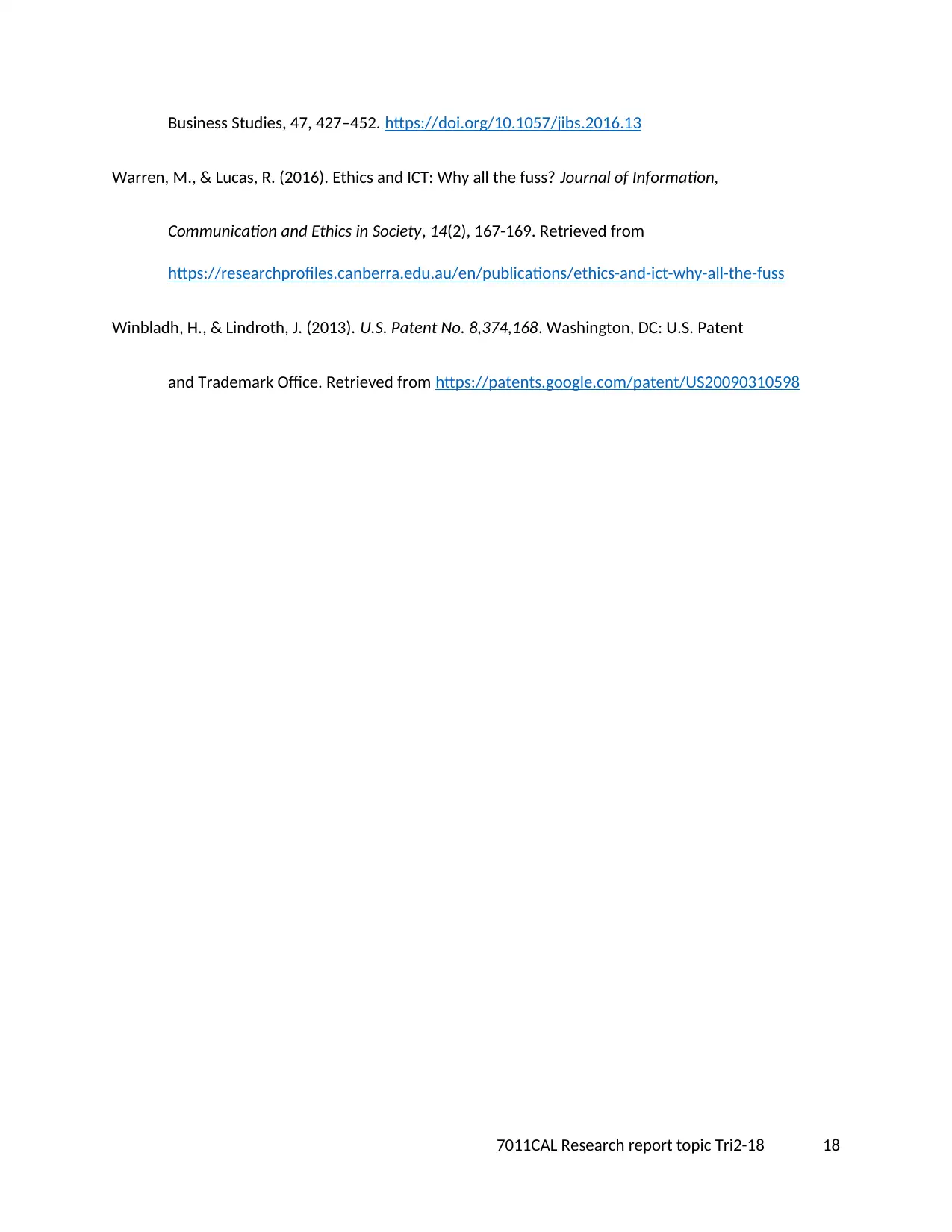
Business Studies, 47, 427–452. https://doi.org/10.1057/jibs.2016.13
Warren, M., & Lucas, R. (2016). Ethics and ICT: Why all the fuss? Journal of Information,
Communication and Ethics in Society, 14(2), 167-169. Retrieved from
https://researchprofiles.canberra.edu.au/en/publications/ethics-and-ict-why-all-the-fuss
Winbladh, H., & Lindroth, J. (2013). U.S. Patent No. 8,374,168. Washington, DC: U.S. Patent
and Trademark Office. Retrieved from https://patents.google.com/patent/US20090310598
7011CAL Research report topic Tri2-18 18
Warren, M., & Lucas, R. (2016). Ethics and ICT: Why all the fuss? Journal of Information,
Communication and Ethics in Society, 14(2), 167-169. Retrieved from
https://researchprofiles.canberra.edu.au/en/publications/ethics-and-ict-why-all-the-fuss
Winbladh, H., & Lindroth, J. (2013). U.S. Patent No. 8,374,168. Washington, DC: U.S. Patent
and Trademark Office. Retrieved from https://patents.google.com/patent/US20090310598
7011CAL Research report topic Tri2-18 18
1 out of 18
Related Documents
Your All-in-One AI-Powered Toolkit for Academic Success.
+13062052269
info@desklib.com
Available 24*7 on WhatsApp / Email
![[object Object]](/_next/static/media/star-bottom.7253800d.svg)
Unlock your academic potential
© 2024 | Zucol Services PVT LTD | All rights reserved.




